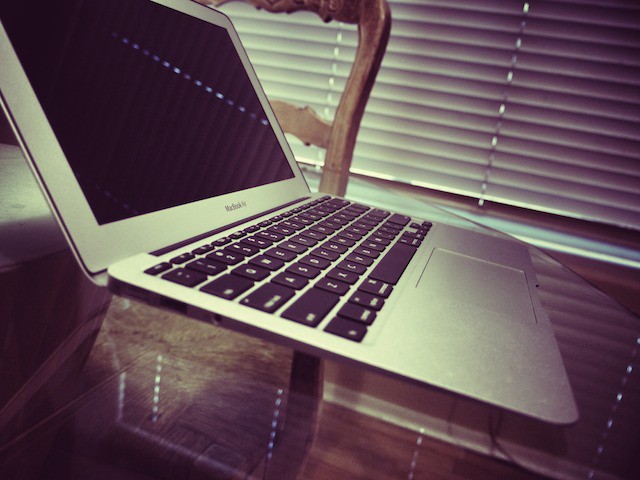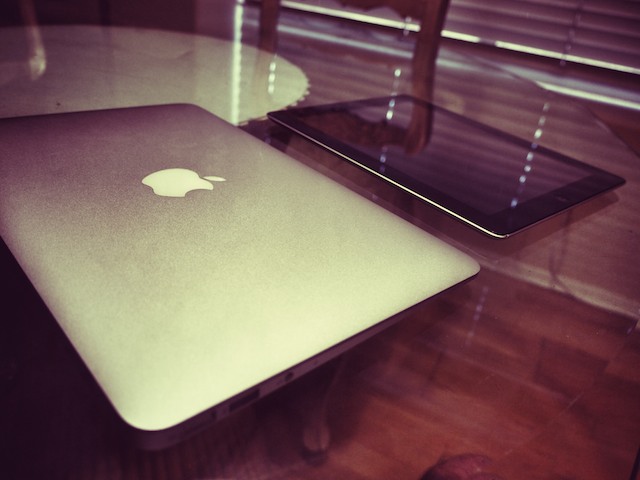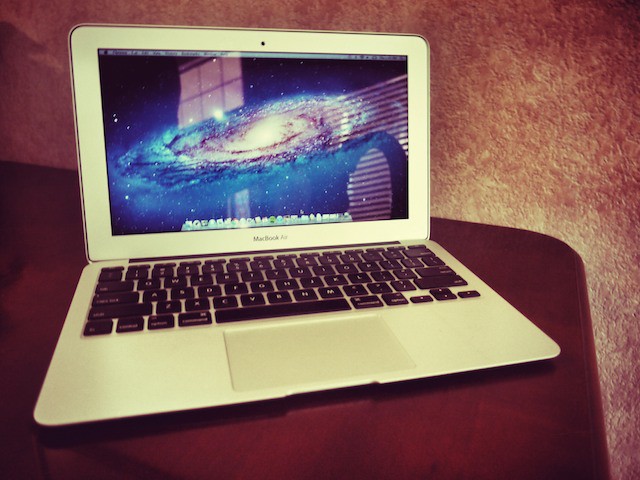Apple’s new 11-inch MacBook Air is simply incredible. Of course you probably already knew this puppy was light, and gorgeous, but the power that this tiny machine packs is truly breathtaking. Optimized for speed and portability, the new MacBook Air improves on its predecessor to prove that it’s the best notebook computer Apple’s ever made.
POWER
When first laying eyes on the MacBook Air, undoubtedly you’ll assume that such a small machine couldn’t possibly replace a beefier MacBook Pro. You’ll probably tell yourself, “Sure, it’s light and thin so it’ll be good for taking on a trip where I don’t need to do any heavy lifting, but it can’t replace my MacBook Pro.” Yet, the most shocking thing about the new 11-inch MacBook Air is that it’s not some wimpy netbook with stylish looks. Apple’s been hard at work ensuring that the MacBook Air is a machine you can actually use in all of your real world scenarios. The spec sheet looks underwhelming (1.6 GHz Intel Core i5, and 4GBs of RAM), but coupled with a Flash Memory Storage that takes advantage of OS X Lion’s Trim support, these new machines are blazing fast.
As soon as I powered up my machine the first thing I did was launch iPhoto, iMovie, iTunes, Spotify, Word, 15 tabs in Chrome, 15 tabs in Safari, download a few files, and copied over some new stuff from an external hard drive all at once. Loading that many tasks on my old 13-inch MacBook Pro would have crippled it, but there sat the new MacBook Air, chugging along without a single spinning beach ball.
According to benchmark tests performed by Wired, the new 11-inch MacBook Airs increased their speed performance by 149% over last year’s model. Their tests put the 11-inch MacBook Air on par with last year’s 17-inch MacBook Pros. The power behind this beautiful machine is incredible, especially when you consider that it’s 2.38lbs is nearly half that of my old 13-inch MacBook Pro (4.22lbs lighter than the 17-inch MacBook Pro it equaled in benchmark tests).
DESIGN
The elegant design of the anorexic MacBook Airs hasn’t changed all that much since the last iteration. It’s skinny and light as ever, with a full-size keyboard, glass multi-touch trackpad, FaceTime Camera, and the same 1366 x 768 screen size. There are a few key differences between the new and old models though. First of all, the new MacBook Airs are rocking a new Thunderbolt port that can be used for lightning fast data transfer, or as a Display Port for an external monitor.
Another key difference is in the keyboard. The new MacBook Airs finally have the backlit keyboard that was missing from the previous model (which was one of the factors that kept me from purchasing one last year). Also, these new machines are the first Macs with hardware designed with OS X Lion in mind. Instead of an Exposé and Dashboard key, users will find new shortcut keys for Mission Control and Launchpad. A dedicated key for Launchpad has improved my Lion experience more than I would have thought. Before having a physical Launchpad key, I didn’t see much difference between clicking on a stacked Applications folder in the dock and clicking on Launchpad.
PORTABILITY
If it weren’t for the MacBook Airs all-metal, unibody frame, I would almost be scared of being able to break it in half. It’s so thin it’s frightening. Portability, with uncompromised speed, is where the MacBook Air excels. It’s hard to discern that the MacBook Air is heavier than an iPad 2. Weighing in at a minuscule 2.3lbs, you can drop the MacBook Air in your bag and never notice it’s there. As someone who’s constantly on the go, it’s shocking how big a difference the loss of 2.2lbs makes when carrying a shoulder bag all day.
To put it into perspective, I can now carry my MacBook Air and my iPad 2 in the same bag, and together they’re .79lbs lighter than if I were to just carry a 13-inch MacBook Pro, while only being .07 inches thicker. Another aspect of the MacBook Air that’s not talked about that much is how narrow it is. Remember those old Sony Vaio P ads with the lady carrying her Vaio in her back pocket? Well you can’t fit the Air in your back pocket, but it is nearly 2.5 inches more narrow than a 13-inch MacBook Pro which makes a big difference in its total volume.
BATTERY
Among all of Apple’s notebooks, the 11-inch MacBook Air actually has the shortest battery life. Apple claims that the battery will last five hours (compared to the seven hours all other MacBooks get). My experience has been on par to the five-hour battery life, while I’ve seen others claim they’re getting a little more juice than that. So far this is the only weakness I’ve seen with the MacBook Air. A longer battery life would be nice, but when you’re playing on a machine this light, it’s hard to complain.
STORAGE
Apple improved the internal storage by beefing the Flash Storage to 256GB. I purchased a unit with the 128GB SSD, which after copying over all my apps, photos and documents, I still have 86GB left. Utilizing cloud storage programs like Spotify and DropBox is key to maintaining enough disk space for maneuverability. Keeping my entire iTunes music library on a portable hard drive will also have to suffice. (Check out our article for tips on making the most of your MacBook Air’s limited diskspace)
The use of Flash Storage makes a huge difference in performance. Writing onto the MacBooks Air’s memory is super quick. Zipping files right along, the MacBook Air is a lot quieter when under a heavy load than other machines I’ve used in the past. Bouncing icons in the dock seem to be a thing of the past, as applications load up drastically faster than on my old MacBook Pro.
SHORTCOMINGS
It’d be nice if the display bezel wasn’t metal and the MacBook Air display was corner to corner glass like on the MacBook Pros and iMacs. Not sure if this choice was made to provide more strength for the top piece or what.
There’s no SD slot on the 11-inch model where there is one on the 13-inch unit. It’s not something I necessarily need, but having one would make transferring photos from my camera a bit easier.
The FaceTime camera isn’t HD like on the MacBook Pros. In fact, when placing a FaceTime call the video quality coming from my camera seemed worse than when I FaceTime on my iPad.
Perhaps I’m the only one, but I really liked the LED Power Indicator on the side of my MacBook Pro. I’m going to miss having a quick way to check how much battery I have left without having to open up the MacBook and check in OS X.
A security lock is still missing from the MacBook Air line.
Upgrade-ability. Not that MacBooks have ever been the most upgradeable machines out there, but with the RAM soldered on to the motherboard, you’re stuck with what you initially purchased. Luckily, the Flash Storage isn’t soldered on too so there’s one thing users can upgrade.
WRAP-UP
Without a doubt, the MacBook Air is Apple’s best notebook computer. Its design has no equal in the world. Even people who couldn’t care less about technology will be in awe of its beauty, and with its improved innards, the MacBook Air can handle some serious computing action.
While it’s no revolution, the new MacBook Airs are a welcomed evolution that will push themselves into the consumer mainstream. Despite its small imperfections, it’s pretty clear that the MacBook Airs are quickly unseating the MacBook Pros as the most desirable notebook on the market.
![Sleek and Powerful, the New 11-Inch MacBook Air Will Blow You Away, Again [Review] macair3](https://www.cultofmac.com/wp-content/uploads/2011/07/macair3.jpg)





83 responses to “Sleek and Powerful, the New 11-Inch MacBook Air Will Blow You Away, Again [Review]”
I think I’ll pick one up tonight.
So close to buying one. I do a bit of gaming on the road, I’m dying to know if this can handle some light gaming?
Nice review, wish you didn’t uglify the photos though!
I have a 2008 aluminum macbook and it has been giving me a lot of problems lately! Considering picking up a air but don’t have enough money and probably won’t make too much selling the macbook.
honestly…the lighting in my house is terrible. They’d be ugly either way.
When I bought my Macbook Air in December I missed the SD slot too. However, a foldable SD to USB card is available that solved all my woes. Only goes up to 4Gb at last look, but that’s enough for me – don’t need a SD card slot now :)
http://www.amazon.co.uk/SanDis…
do you have a game in mind? i’ll try and test it.
Soon I will have one – I can feel it in my old tired bones. Soon.
Currently work on a 13 inch oder MBA and curious if using the smaller screen bothered you at all. Especially since Lion supports full screen apps. Does it feel to small to watch a movie or edit a long doc if you did not have an external monitor handy?
The first thing I’ve noticed was the lo-fi photo effect!! Love it!! People are different. ;))
Try Civilization V and I’d be eternally grateful.
It’s on sale in the MAS now, coincidentally…
perhaps next year, they’ll add a 15 inch version to the Air family.
Or they won’t and just slim the MacBook Pro instead. NOTHING is a guarantee.
I’m going to buy the late 2010 13” model for $999 on the Apple site. And with educational pricing at my local electronics shop it drops down to $899. Way better deal when this machine will see yet another update within a years time. I’m saving my pennies for the new MacBook Pro’s in early 2012, which will most likely see an entirely slender new redesign. GREAT review regardless.
Just got one to replace my 2010 version too. It is by far, the notebook of notebooks.
Great review! :) i’d love to get a mba but i dont have the cash.
Did you think about the 13″ at all? Since I would go 4GB on either, it is $100 for the slightly larger screen, slightly faster CPU, an SD Slot(not huge deal), and much better battery?
I think the half pound and 100 dollars might be worth the tradeoff.
thanks for the great review…based on your guys’ recommendations I went and bought the one you recommended…11″, 4G, 128GB model. Really impressed. I thought the smaller screen would bug the crap out of me…but I have to say it actually is ok this way. I’m really liking the way Lion works on this machine. I bought the Apple Super Drive to install a couple of discs, and my Office 2011 stuff works great…very very fast. The startup on the machine and on the apps I re-downloaded are pretty great. I’ll keep you posted as I learn more about my little baby. I really appreciate your review and your recommendations…awesome job!
Very poor performance. Do not buy from Mr. Jobs’ to the computer. In Russia, the Macintosh no interest.
Well if we are talking about light notebook which should be ‘easy to carry and portable’ than those 5 hours on batteries means it rather sucks or am I wrong?
Great article
Wow What a mind blowing seek design……….Stunning look and brilliant features.
Are you guys looking for iPhone apps.? Take a look at this:http://itunes.apple.com/us/app…
Disgusting quality, plus the impossibility of an upgrade as well MacBook Air!
While I’ve been waiting to see a few reviews and still are(specially from Anandtech), I must say, it did blow me away, in a pretty disappointing way. I really hoped they would up the SSD or at the very least the RAM in the base models.
I’ve been waiting for this refresh and planned to get one, now I am more leaning towards buying the old model that people will be selling at half the price…
Aperture = one click white balance correction
I’d like to know if Civ V runs well on it, too. I can guarantee that it doesn’t work well on the 2010 11″ Air 1.4 Ghz C2D w/ 2GB memory, which isn’t exactly a shocker.
smaller monitor doesn’t bother me. It’s in your lap so it’s not like you’re starring at a small screen a 10 feet away.
battery life isn’t the best, which I did note. 5 hours will only last you a plane ride from LA to NYC…but that’s where an iPad comes in
Buster, thank you for this review. You made me make my decision. Now, I’ve decided. I’ll get a MacBook Air 11″ 128GB SSD with a Henge Dock, an Apple Keyboard and a high-capacity USB thumb-drive. By the way, how do I use an external monitor? Do I need to get a Thunderbolt -> VGA / HDMI adapter?
Indeed, the fact I cannot play call of duty 4 anymore compared to my 2010 c2d 320m mbp blew me away. Thanks a lot intel tards with their crappy 3000HD integrated crapchipset.
I am pretty sure you guys rather unrar files 30% faster than play video games on the go.
Frankly, the upgrade to i5 is a downgrade, there is no speed difference at all due to the SSD in menus or internet browsing or opening photoshop.
Trust me you better buy a 2010 maxed out mba for cheaper than this new downgraded mba… I am hoping the next intel chipsets will at least be on par with a 320m or else I am not buying mbas anymore when refresh time comes through.
tinyurl.com/3oqxhvp
I just got my new Air yesterday, and I love it. Even the hidden speakers sound great, which was a pleasant surprise. This machine is just magical, and I am totally addicted, I’ll admit.
So sad for Russia.
Is there a better quality notebook that you would recommend?
wow, you’re everywhere troll boy. lol
In soviet Russia, macbook buys YOU
your post is like one of those hilarious come-ons from a “hot russian woman.” remember them? sure you do. you probably wrote a few yourself.
they were all cheesy soft-core pitches written by a bunch of fat, greasy trolls, passing them back and forth between russian and english translations on babel fish. nice work.
If you could fix that up to a suitable condition, a lot of people would buy an Aluminum Macbook. I’ve seen some go for $700! More often then not though, you can get $300-$500.
I found this new apple blog and its great!
http://applefanboynews.com/
Hi Heine,
first off that was a great review. I wanted to ask you, I’m currently using a 13″ MacBook Pro June 09 model with 4GB of ram with the 2.53GHz Processor. I want to buy that new 11″ Air with the i5 and 4GB + 128GB SSD and was wondering in terms of performance will It be faster?
I currently edit with Final Cut Pro X on my 13″ Pro and is so far sufficient. I know hard drive space will be a concern so I will buy a external usb drive to store my events and I could probably keep one or two projects on the MacBook Air SSD anyway.
In terms of display the 11″ air 1336×768 is kinda equal to my 1280×800 since my dock is not on hide I usually edit at 1280×720 so I don’t think I’d have a problem editing on the 11″ Plus I have an external monitor.
The biggest question is, is the i5 Processor faster than the Duo 2.53GHz or should I save a bit more cash and go for the i7. I’d love to try stick with the i5 to keep the cost down. And is the graphics on it nearly on par with the 9400m in terms of openCL capability?
Thanks,
Lee-Loi Chieng.
Just bought my MBA 11/icore7/256 Gb….. expensive but really amazing !!
It is really fast !!
Pretty sure I’ll be breaking up with my 2010 MBP this week for one of these 13 in bad boys.